
Concept explainers
(a)
Interpretation:
The product formed should be determined on the reaction of following

Concept Introduction:
A
In a chemical reaction, the substance which is involved in conversion is said to be reactant, whereas, the newly formed substance is known as a product. Both reactants and products must be separated by an arrow.
Hydration reaction is an addition reaction in which the hydrogen and hydroxyl group (-OH) are bonded on un-statured carbon atoms of alkene to form alcohol.
Answer to Problem 13.62P
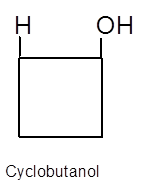
Explanation of Solution
To get the hydration product of any alkene, three steps must be followed:
- Locate the position of C=C in the molecule.
- Break the H-OH bond of the reagent.
- Add the -OH group atom to double-bonded C atom to form new C−OH single bonds in the molecule.
- Add one H atom to another double-bonded C atom to form new C−H single bonds in the molecule.
- The reaction follows the Markovnikov rule which states that the H atom of H-OH will bond to that double-bonded C atom which has more number of H atoms.
Hence, the hydration product is:
. 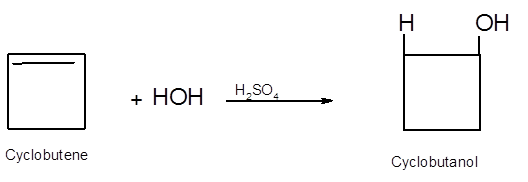
(b)
Interpretation:
The product formed should be determined on the reaction of following alkene with
(CH3)3 -C =C -(CH3)2
Concept Introduction:
A chemical reaction is the symbolic representation of the conversion of substances to new substances.
In a chemical reaction, the substance which is involved in conversion is said to be reactant, whereas, the newly formed substance is known as a product. Both reactants and products must be separated by an arrow.
Hydration reaction is an addition reaction in which the hydrogen and hydroxyl group (-OH) are bonded on un-statured carbon atoms of alkene to form alcohol.
Answer to Problem 13.62P

Explanation of Solution
To get the hydration product of any alkene, three steps must be followed;
- Locate the position of C=C in the molecule.
- Break the H-OH bond of the reagent.
- Add the -OH group atom to double-bonded C atom to form new C−OH single bonds in the molecule.
- Add one H atom to another double-bonded C atom to form new C−H single bonds in the molecule.
- The reaction follows the Markovnikov rule which states that the H atom of H-OH will bond to that double-bonded C atom which has more number of H atoms.
Hence, the hydration product is:

(c)
Interpretation:
The product formed should be determined on the reaction of following alkene with

Concept Introduction:
A chemical reaction is the symbolic representation of the conversion of substances to new substances.
In a chemical reaction, the substance which is involved in conversion is said to be reactant, whereas, the newly formed substance is known as a product. Both reactants and products must be separated by an arrow.
Hydration reaction is an addition reaction in which the hydrogen and hydroxyl group (-OH) are bonded on un-statured carbon atoms of alkene to form alcohol.
Answer to Problem 13.62P
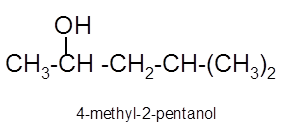
Explanation of Solution
To get the hydration product of any alkene, three steps must be followed;
- Locate the position of C=C in the molecule.
- Break the H-OH bond of the reagent.
- Add the -OH group atom to double-bonded C atom to form new C−OH single bonds in the molecule.
- Add one H atom to another double-bonded C atom to form new C−H single bonds in the molecule.
- The reaction follows the Markovnikov rule which states that the H atom of H-OH will bond to that double-bonded C atom which has more number of H atoms.
Hence, the hydration product is:

(d)
Interpretation:
The product formed should be determined on the reaction of following alkene with

Concept Introduction:
A chemical reaction is the symbolic representation of the conversion of substances to new substances.
In a chemical reaction, the substance which is involved in conversion is said to be reactant, whereas, the newly formed substance is known as a product. Both reactants and products must be separated by an arrow.
Hydration reaction is an addition reaction in which the hydrogen and hydroxyl group (-OH) are bonded on un-statured carbon atoms of alkene to form alcohol.
Answer to Problem 13.62P
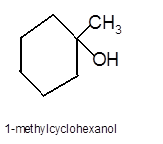
Explanation of Solution
To get the hydration product of any alkene, three steps must be followed;
- Locate the position of C=C in the molecule.
- Break the H-OH bond of the reagent.
- Add the -OH group atom to double-bonded C atom to form new C−OH single bonds in the molecule.
- Add one H atom to another double-bonded C atom to form new C−H single bonds in the molecule.
- The reaction follows the Markovnikov rule which states that the H atom of H-OH will bond to that double-bonded C atom which has more number of H atoms.
Hence the hydration product is:
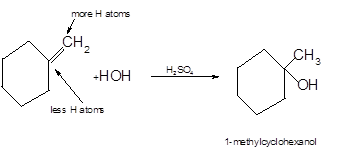
Want to see more full solutions like this?
Chapter 13 Solutions
EBK GENERAL, ORGANIC, & BIOLOGICAL CHEM
- For Raman spectroscopy/imaging, which statement is not true regarding its disadvantages? a) Limited spatial resolution. b) Short integration time. c) A one-dimensional technique. d) Weak signal, only 1 in 108 incident photons is Raman scattered. e) Fluorescence interference.arrow_forwardUsing a cell of known pathlength b = 1.25115 x 10-3 cm, a water absorption spectrum was measured. The band at 1645 cm-1, assigned to the O-H bending, showed an absorbance, A, of 1.40. a) Assuming that water density is 1.00 g/mL, calculate the water molar concentration c (hint: M= mole/L) b) Calculate the molar absorptivity, a, of the 1645 cm-1 band c) The transmitted light, I, can be written as I= Ioexp(-xb), where x is the absorption coefficient (sometimes designated as alpha), Io is the input light, and b is the cell pathlength. Prove that x= (ln10)*x*c. (Please provide a full derivation of the equation for x from the equation for I). d) Calculate x for the 1645 cm-1 bandarrow_forwardI need help with the follloaingarrow_forward
- For a CARS experiment on a Raman band 918 cm-1, if omega1= 1280 nm, calculate the omega2 in wavelength (nm) and the CARS output in wavelength (nm).arrow_forwardI need help with the following questionarrow_forwardFor CARS, which statement is not true regarding its advantages? a) Contrast signal based on vibrational characteristics, no need for fluorescent tagging. b) Stronger signals than spontaneous Raman. c) Suffers from fluorescence interference, because CARS signal is at high frequency. d) Faster, more efficient imaging for real-time analysis. e) Higher resolution than spontaneous Raman microscopy.arrow_forward
- Draw the major product of the Claisen condensation reaction between two molecules of this ester. Ignore inorganic byproducts. Incorrect, 5 attempts remaining 1. NaOCH3/CH3OH 2. Acidic workup Select to Draw O Incorrect, 5 attempts remaining The total number of carbons in the parent chain is incorrect. Review the reaction conditions including starting materials and/or intermediate structures and recount the number of carbon atoms in the parent chain of your structure. OKarrow_forwardUsing a cell of known pathlength b = 1.25115 x 10-3 cm, a water absorption spectrum was measured. The band at 1645 cm-1, assigned to the O-H bending, showed an absorbance, A, of 1.40. a) Assuming that water density is 1.00 g/mL, calculate the water molar concentration c (hint: M= mole/L) b) Calculate the molar absorptivity, a, of the 1645 cm-1 band c) The transmitted light, I, can be written as I= Ioexp(-xb), where x is the absorption coefficient (sometimes designated as alpha), Io is the input light, and b is the cell pathlength. Prove that x= (ln10)*x*c d) Calculate x for the 1645 cm-1 bandarrow_forwardConvert 1.38 eV into wavelength (nm) and wavenumber (cm-1) (c = 2.998 x 108 m/s; h = 6.626 x 10-34 J*s).arrow_forward
 Organic And Biological ChemistryChemistryISBN:9781305081079Author:STOKER, H. Stephen (howard Stephen)Publisher:Cengage Learning,
Organic And Biological ChemistryChemistryISBN:9781305081079Author:STOKER, H. Stephen (howard Stephen)Publisher:Cengage Learning, General, Organic, and Biological ChemistryChemistryISBN:9781285853918Author:H. Stephen StokerPublisher:Cengage Learning
General, Organic, and Biological ChemistryChemistryISBN:9781285853918Author:H. Stephen StokerPublisher:Cengage Learning Introduction to General, Organic and BiochemistryChemistryISBN:9781285869759Author:Frederick A. Bettelheim, William H. Brown, Mary K. Campbell, Shawn O. Farrell, Omar TorresPublisher:Cengage Learning
Introduction to General, Organic and BiochemistryChemistryISBN:9781285869759Author:Frederick A. Bettelheim, William H. Brown, Mary K. Campbell, Shawn O. Farrell, Omar TorresPublisher:Cengage Learning Chemistry for Today: General, Organic, and Bioche...ChemistryISBN:9781305960060Author:Spencer L. Seager, Michael R. Slabaugh, Maren S. HansenPublisher:Cengage Learning
Chemistry for Today: General, Organic, and Bioche...ChemistryISBN:9781305960060Author:Spencer L. Seager, Michael R. Slabaugh, Maren S. HansenPublisher:Cengage Learning Chemistry & Chemical ReactivityChemistryISBN:9781133949640Author:John C. Kotz, Paul M. Treichel, John Townsend, David TreichelPublisher:Cengage Learning
Chemistry & Chemical ReactivityChemistryISBN:9781133949640Author:John C. Kotz, Paul M. Treichel, John Townsend, David TreichelPublisher:Cengage Learning Chemistry & Chemical ReactivityChemistryISBN:9781337399074Author:John C. Kotz, Paul M. Treichel, John Townsend, David TreichelPublisher:Cengage Learning
Chemistry & Chemical ReactivityChemistryISBN:9781337399074Author:John C. Kotz, Paul M. Treichel, John Townsend, David TreichelPublisher:Cengage Learning





